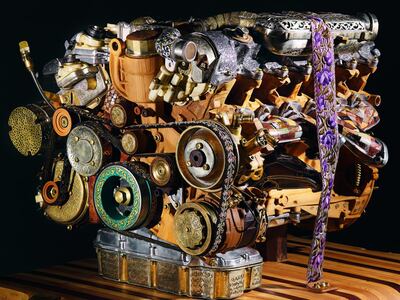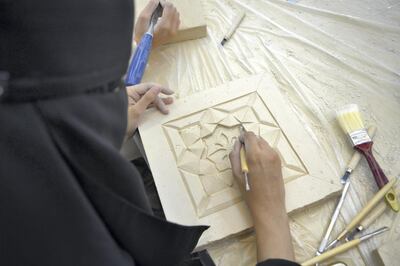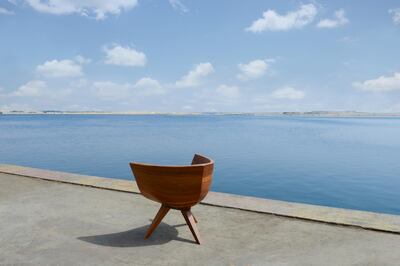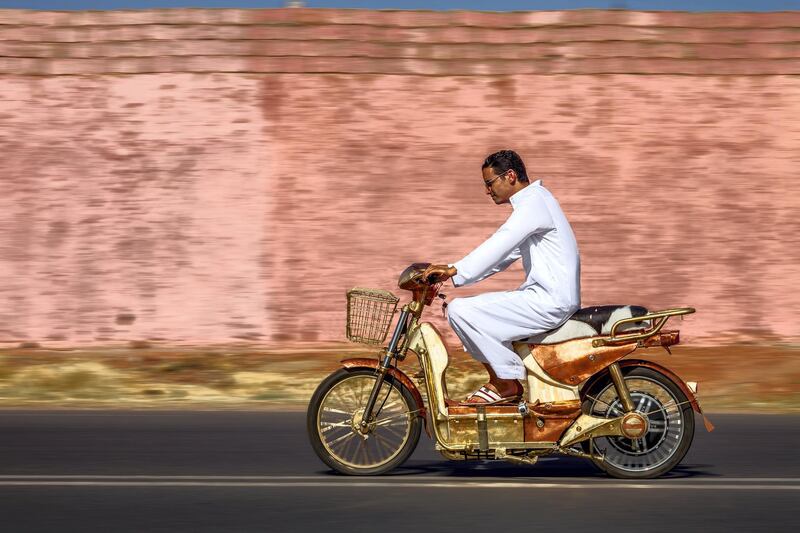Eric van Hove, of Belgian descent, was born in Algeria, raised in Cameroon, studied calligraphy in Japan and then spent a decade making conceptual art in more than 100 countries, before he finally settled in Morocco in 2012.
The artist was drawn to the country, in part, by the story of the Laraki Fulgura, which was billed as the first all-Moroccan supercar when it was unveiled at the Geneva Motor Show in 2002. Although it was designed and built by Casablanca's Laraki Automobiles SA, the US$555,750 (Dh2 million) vehicle generated its 920 horsepower thanks to a German Mercedes 6.2L V12, an anomaly that gave van Hove the idea of recreating the engine in Morocco, using the traditional craft skills for which the country is famed.
Van Hove set up an atelier in Sidi Moussa, a village that sits between Marrakech and the Atlas Mountains and, within nine months, he had assembled a project team of 42 craftsmen, each a specialist in a particular material or technique. Piece by piece, the team began to recreate the engine in meticulous detail, using 53 traditional materials such as Moroccan beech wood, mother-of-pearl, goat bone, malachite, argan oil, cow horn and even 400-million-year-old fossilised ammonites, which form the heads of the engine’s pistons.
Engraved with the names of every craftsman involved, van Hove's V12 Laraki (2013) was exhibited at the fifth Marrakech Biennale before it was acquired by the Hood Museum of Art in the United States.

The atelier went on to produce more exquisite engines until 2016, when the nature of its work underwent a fundamental change.
With the Mahjouba I and the subsequent Mahjouba Initiative, van Hove began to work with a smaller team and narrower palette of materials to create fully functional, handmade electric mopeds.
"We are trying to produce an electric motorbike made by local craftsmen, combined with 3D printing, for the local market," the artist explains to an international audience of curators, academics, students and creatives who gathered last week at Middle Eastern Crafts: Yesterday, Today and Tomorrow, at the Victoria and Albert Museum in London.
For van Hove, who sees the mopeds as "socio-economic sculptures" or disruptive consumer goods, the Mahjouba Initiative has the potential to reconfigure the relationship among art, craft and entrepreneurship in Morocco, a country where an estimated 20 per cent of the workforce is employed in artisanal industries, and that also aspires to generate 42 per cent of its energy from renewables by 2020.
In a manner that chimed perfectly with the ideals of 19th-century craftsmen and designers, such as William Morris, who played such a vital role in the early establishment of the V&A’s Islamic Middle Eastern collections, van Hove suggests that the Mahjouba Initiative offers a new economic model in which the crafts might help to reintroduce beauty, enthusiasm and meaning into people’s working lives.
“The means of production lifts up the hearts of people. It inspires them. [If it works,] I think that would be a very significant artwork and as an artist I would be satisfied.”
Art Jameel at the V&A
The two-day conference attracted delegates from projects in Morocco, Egypt, Kuwait, Palestine, Saudi Arabia, the UAE and Afghanistan, and provided a snapshot of the vital role that traditional crafts are playing, not just in the preservation and rejuvenation of age-old traditions, but also in entrepreneurial programmes and regeneration projects throughout the Islamic world.
Art Jameel’s head of heritage, George Richards, outlined the ways in which the educational programmes offered by the Jameel House of Traditional Arts in Cairo and Jeddah have contributed to the recording and restoration of those cities’ architectural heritage.

Opened in 2015 in a traditional coral-stone house in the heart of the Old Town of Jeddah, the Jameel House of Traditional Arts – Jeddah offers year-long programmes in conjunction with the Prince’s Foundation School of Traditional Arts in London, which focuses on Islamic geometry, patterns and design, nabati decorative techniques, woodwork and traditional gypsum-carving.
"We teach these crafts with a view to preserving them as intangible cultural heritage, but it's also about the creation of a new generation of artisans. [They] can contribute to the regeneration of these monuments, not just to rely on conservation as a tool of restoration, but also to regenerate crafts that can produce new works," Richards explains, outlining the ways in which the historic urban fabric in places such as Cairo and Jeddah forms a palette, a studio and a laboratory where artists and artisans can hone their skills.
“By having traditional arts institutes like ours, it means that these historic city quarters are revitalised as places of craft as they once would have been, and that by reintroducing and revitalising these crafts, we are revitalising the urban environment.”
Tanween by Tashkeel
With the Jameel Arts Centre about to open in Dubai in November, Richards' presentation wasn't the only part of the conference to have links with the UAE. Presenting Tanween, Tashkeel's professional development programme for emerging makers and artisans, Lisa Ball-Lechgar proposed that the emergence of a new generation of designers such as Studio Muju and Rand Abdul Jabbar, both former Tanween alumni is contributing towards the emergence of a UAE design aesthetic that blends a certain cosmopolitanism with local traditions, materials and techniques.

That consideration – of the presence of the past in the present – is one of the ideas that guides Marie-Claire Bakker's teaching at Zayed University, where students are encouraged to learn traditional Emirati crafts from their family or community and to incorporate this in their contemporary design practice.
“For my students, what is important is knowing their own craft history. If they subsequently decide to use those crafts in their designs or not, they are at least coming from a place of knowledge when they make that decision,” explains Bakker, who attended the conference with a group of students from the university’s College of Arts and Creative Enterprises in Abu Dhabi.
“I think it is important that what they decide to take forward and adapt and innovate with has to come from a deep knowledge of their own heritage, and in this context they can see how other artists and designers have approached this,” explains Bakker.
Rather than focusing on craft's relationship with aesthetics and cultural identity, Middle Eastern Crafts: Yesterday, Today and Tomorrow shows how the sector can engage critically with wider issues of education, economic empowerment, entrepreneurship, conservation and regeneration while operating at various scales, as Ernesto Rogers once said, from the spoon to the city.
“Here you have artists, designers, major philanthropic institutions and academics, all in the same space, talking about these issues,” Bakker says. “We should be organising conferences and opportunities like this in the UAE. We have speakers here from the region talking about the UAE and Saudi Arabia, and so I think that’s possible and we need to facilitate that in some way.”
___________________
Read more:
[ Elias and Yousef Anastas: the artisans mastering musical chairs ]
[ Pattern recognition: examining the draw of Orla Kiely’s distinctive designs ]
[ UAE exhibition at London Design Festival presents objects imbued with history ]
___________________





